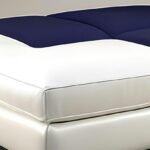Introduction to Futon Beds
Futon beds have their origins in traditional Japanese bedding systems, where they were designed to be compact and versatile. The original ‘shikibuton’ is a simple mattress placed directly on the tatami floor, allowing for easy storage during the day when not in use. Over time, this functional and space-saving concept underwent various adaptations, leading to the modern futon beds we recognize today. These contemporary versions typically consist of a mattress and a frame that can transition between a bed and a sofa, catering to the needs of individuals in multi-functional living spaces.
The inherent dual functionality of futon beds makes them particularly appealing for those residing in small apartments or for homeowners looking to optimize guest room space. This adaptability not only provides seating during the day but also transforms into a comfortable sleeping arrangement at night. This flexibility has contributed to the rising popularity of futon beds among minimalists and those who prioritize functionality without compromising on style.
Diverse types of futon beds are now available in the market. They range from traditional Japanese designs featuring thin mattresses and low profiles to Western variants that resemble conventional couch beds. Some of these selections include sleeper sofas and futon frames made from various materials, providing a range of aesthetic options. Additionally, mattress thickness, materials, and firmness levels can significantly influence the comfort of a futon bed. Understanding these varieties sets the stage for a deeper discussion on the comfort aspects of futon beds, which is essential for anyone considering this versatile bedding option.
The Anatomy of a Futon Bed: Components that Affect Comfort
Understanding the comfort level of a futon bed requires a closer examination of its fundamental components. Central to any futon is the mattress, which significantly influences the quality of sleep it offers. Futon mattresses can vary widely in material, including cotton, foam, and innerspring options. Cotton futon mattresses tend to be traditional and breathable, offering a medium level of support. However, they can compress over time and may require regular flipping and airing out for optimal comfort. In contrast, foam mattresses provide higher durability and support, often featuring layers of various densities to cater to different comfort preferences. Innerspring futon mattresses, sometimes less common, incorporate coils for added bounce and support, appealing to those who prefer a more conventional mattress feel.
The futon frame also plays a crucial role in overall comfort. Frames can be constructed from wood, metal, or specialized convertible designs that allow easy transformation from seating to sleeping. Wooden frames often provide sturdiness and aesthetic warmth, while metal frames offer a sleek, modern look and may generally allow for a more compact design. Convertible frames enhance versatility, yet their support may vary and can play a role in how stable the mattress feels during sleep.
Additional factors such as mattress thickness and firmness further influence the futon bed’s comfort. Thicker mattresses tend to provide more support, aligning the spine properly, while firmness options allow users to select their preferred feel. A firmer bed is often beneficial for those with back pain, whereas a softer bed can be more suitable for lighter individuals or those who enjoy sinking into their mattresses. Ultimately, a comprehensive understanding of these components can guide potential users in selecting a futon bed that meets their comfort needs effectively.
Comfort vs. Support: What to Look For
When evaluating the comfort of a futon bed, it is essential to consider the balance between comfort and support, as both are critical to a good night’s sleep. A supportive sleeping surface ensures that the spine remains aligned and pressure points are minimized, while comfort contributes to an overall pleasant sleeping experience. Several factors influence how comfortable a futon bed may feel, including the materials used, the thickness of the mattress, and the individual’s unique sleeping preferences.
One of the most prominent aspects to look for in a futon is the mattress composition. Futon mattresses typically consist of various materials such as cotton, foam, or innerspring coils. High-density foam can provide excellent support, contouring to the body’s shape while maintaining durability. On the other hand, traditional cotton futons offer a softer, more plush feel but may lack the necessary support for some users. Therefore, evaluating both options can help individuals find a futon that meets their comfort and support needs.
Moreover, sleeping position significantly impacts the requirements for comfort and support. For instance, side sleepers often fare better with a softer mattress that cushions the shoulders and hips, while back sleepers may prefer a firmer support level to maintain spinal alignment. Additionally, body type plays a crucial role; heavier individuals may require additional support to prevent sinking too deeply into the mattress, whereas lighter individuals might lean towards softer options for their comfort.
When selecting a futon bed, it is advisable to test various models to determine personal preferences. Look for futons that combine a supportive core with ample cushioning on the surface, and consider taking note of the warranty and return policy. In conclusion, a well-chosen futon that balances comfort and support can contribute significantly to a restful and rejuvenating sleep experience.
User Experiences: Pros and Cons of Sleeping on Futons
Futon beds have garnered a variety of opinions from users, making it essential to explore the experiences of those who have spent nights on these versatile sleeping arrangements. Many individuals appreciate the space-saving advantages that futon beds offer, especially in smaller living environments. For instance, college students or urban dwellers often find that futon beds double as a sofa during the day, enhancing multifunctionality in their homes.
Moreover, the maintenance of futon beds is generally straightforward. Users frequently mention that futon covers are easy to clean, allowing for effortless upkeep. This aspect has been particularly beneficial for families with children or pets, as spills and stains can be dealt with promptly. Additionally, the lightweight design of futons enables users to maneuver them easily, which can be a significant advantage when rearranging living spaces.
However, not all experiences with futon beds are positive. Several users have reported discomfort after sleeping on a futon for extended periods. The mattress quality varies significantly between different brands and models, leading to complaints about inadequate support. Individuals with back pain or specific sleeping preferences may find traditional mattresses more suitable for a good night’s rest. Some users also noted that futons do not provide the same level of insulation as standard beds, which could affect sleep quality during colder months.
Another common concern is the durability of futon beds. While some users appreciate their adaptability, others have pointed out that frequent folding and unfolding can lead to wear and tear over time. This aspect highlights the importance of considering personal needs and sleeping habits when selecting a sleeping solution. Overall, the pros and cons of futon beds depend largely on individual preferences and living conditions.
Comparing Futons to Traditional Mattresses
When evaluating sleep options, it is essential to consider the fundamental differences between futon beds and traditional mattresses. Each bedding type offers unique benefits and drawbacks, influencing the overall comfort and suitability for various lifestyles and needs.
In terms of comfort, traditional mattresses typically provide a wide range of firmness options, catering to individual preferences. They are designed with advanced materials, including memory foam and gel technologies, which offer tailored support and weight distribution. This can greatly enhance sleeping quality, particularly for those with specific health concerns such as back pain. Conversely, futon beds, commonly made from cotton or polyester, may initially seem less comfortable. However, modern futons have evolved to include better cushioning and support, which may appeal to individuals who prefer a firmer sleeping surface. For guests or family members who may only use the bed occasionally, a futon can provide sufficient comfort without the investment required for a full mattress.
Durability is another critical comparison point. Traditional mattresses are designed for long-term use, often lasting between 7 to 10 years, depending on maintenance and quality. In contrast, futons generally have a shorter lifespan, particularly if used regularly as a primary sleeping surface. They may need to be replaced more frequently due to wear and tear. Nonetheless, futons tend to be more versatile, often functioning as both a couch and a bed, making them a valuable choice for small spaces or multipurpose rooms.
Price is a significant factor when comparing these options. Futon beds tend to be more budget-friendly compared to traditional mattresses, making them an attractive choice for individuals seeking an economical solution. In certain scenarios, such as college dormitories, guest rooms, or temporary living situations, a futon can offer a practical sleeping solution without compromising on style or functionality.
How to Improve Futon Comfort: Tips and Tricks
Enhancing the comfort level of a futon bed involves several strategies that cater to different sleeping preferences. One highly recommended approach is the use of a mattress topper. A quality mattress topper can significantly improve the sleeping surface of a futon, providing extra cushioning and support. Options range from memory foam to latex, allowing you to choose based on your desired firmness and pressure relief. When selecting a mattress topper, consider its thickness, density, and material to ensure it complements the futon’s existing structure.
In addition to a mattress topper, appropriate bedding choices can also elevate your sleeping experience. Opting for high-quality sheets made from breathable materials, such as cotton or bamboo, can enhance comfort by regulating temperature throughout the night. A cozy blanket or duvet can provide additional warmth and softness, enhancing the overall feel of the futon. Remember to choose bedding that fits properly to avoid uncomfortable bunching during sleep.
Pillow arrangements play a crucial role in promoting comfort, especially for those who prefer specific sleeping positions. For side sleepers, a thicker pillow placed between the head and neck can ensure proper spinal alignment. Back sleepers may benefit from a medium-sized pillow that supports the natural curve of the neck. Furthermore, for stomach sleepers, a thinner pillow is advisable to prevent strain on the neck and back.
Lastly, to prolong both the comfort and lifespan of a futon, regular maintenance is essential. This includes rotating and flipping the futon mattress periodically to avoid uneven wear. Additionally, clean the futon according to the manufacturer’s guidelines—often using mild detergents and appropriate cleaning techniques. With these tips, you can enhance the overall comfort of your futon bed, making it a viable and supportive sleeping option.
Identifying the Right Futon for Your Needs
Choosing the right futon involves a comprehensive evaluation of your specific needs and lifestyle preferences. As futon beds vary significantly in terms of comfort, design, and usability, it is essential to assess several factors before making a decision.
Firstly, consider the primary use of the futon. Is it intended for regular sleep or merely as an occasional guest bed? If you plan to use it nightly, investing in a high-quality mattress with supportive coils and durable fabric is advisable. These must support your body adequately, ensuring a restful night’s sleep. On the other hand, if the futon will be used sporadically, a more economical option may suffice, provided it meets basic comfort standards for short stays.
Next, space availability is a crucial element in selecting a futon. Evaluate the dimensions of the area where the futon will be placed. Measure the floor space, and take into account any surrounding furniture. A compact futon may be ideal for smaller rooms, while a larger model could compliment more expansive areas. Additionally, if you anticipate frequent conversion from sofa to bed, opt for a design that allows for easy transition and isn’t overly cumbersome.
Aesthetic preferences also play a vital role in futon selection. The futon should harmonize with your existing decor and personal style. Consider designs that fit within your chosen theme, whether modern, rustic, or minimalist. Fabrics and colors available in futon mattresses and frames can greatly enhance the overall look of your space.
To streamline your decision-making process, compile a checklist of questions. This may include: How often will the futon be used? What is the available space in the room? What style or color would best match my decor? Addressing these points will assist in identifying the perfect futon that aligns with your needs.
Alternatives to Futon Beds: What Are Your Options?
When considering alternatives to futon beds, it is essential to evaluate options such as sofa beds, daybeds, and Murphy beds. Each alternative provides distinct features that contribute to comfort, versatility, and space efficiency, making them suitable for various living situations. Understanding these options will help you make an informed decision when searching for the perfect addition to your home.
Sofa beds, also known as sleeper sofas, have gained popularity due to their dual functionality. These pieces of furniture can be used as a traditional sofa during the day and easily converted into a bed at night. Most modern sofa beds offer significant improvements over past models, featuring memory foam mattresses or innerspring options that enhance sleep quality. Additionally, they are available in a wide range of styles, colors, and sizes, making it easy to find one that complements your existing decor.
Daybeds present another attractive alternative for those seeking versatility in their spaces. A daybed serves as both a seating area and a bed, making it particularly suitable for smaller rooms or multi-functional spaces. Many daybeds come with trundle options, allowing for extra sleeping accommodations. They are often styled in a manner that fits seamlessly into a living room or guest room, providing comfort without compromising aesthetics.
Murphy beds, or wall beds, offer a space-saving solution that is ideal for those with limited square footage. These beds can be folded into the wall when not in use, freeing up valuable floor space. Murphy beds are designed to be durable and comfortable, with various mattress thickness options available, ensuring a good night’s sleep. Additionally, they can be incorporated into cabinetry or used in combination with a desk or shelving units, further enhancing their utility.
With various alternatives to futon beds available on the market, you need to consider your specific needs and space requirements. Sofa beds, daybeds, and Murphy beds present different advantages that may better suit your lifestyle, making them worthy contenders in your search for the ideal sleeping solution.
Conclusion: The Comfort Factor in Futon Beds
In wrapping up our exploration of the comfort associated with futon beds, it is essential to highlight that the perception of comfort is subjective and can vary greatly among individuals. Throughout the discussion, we have identified several key aspects that contribute to the overall comfort of futon beds. These include the quality of the mattress, the design of the frame, and the intended use of the futon, whether for sleeping or casual seating. The versatility of futon beds allows them to serve multiple purposes in a living space, which is particularly appealing for those with limited room availability.
Additionally, the materials used in the construction of futon mattresses play a significant role in user comfort. Options range from traditional cotton-filled mattresses to modern gel or memory foam variants. Each material offers distinct benefits and can cater to different sleep preferences, such as those who require extra support or those who prefer a softer sleep surface. It is evident that there is a futon model to suit nearly every individual’s sleeping style.
Ultimately, personal preference will dictate how comfortable a futon bed feels for each person. While some may find futons luxurious and suitable for full-time sleeping, others might feel they are best reserved for occasional use. To truly assess the comfort levels of various futon beds, we encourage readers to visit showrooms to test different models personally. Engaging directly with the futons will provide a better sense of how each design meets individual comfort needs. Moreover, further research into various futon models can help in making a more informed decision, ensuring that one chooses a bed that suits both style and comfort in their living space.






